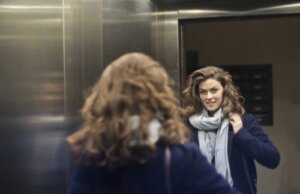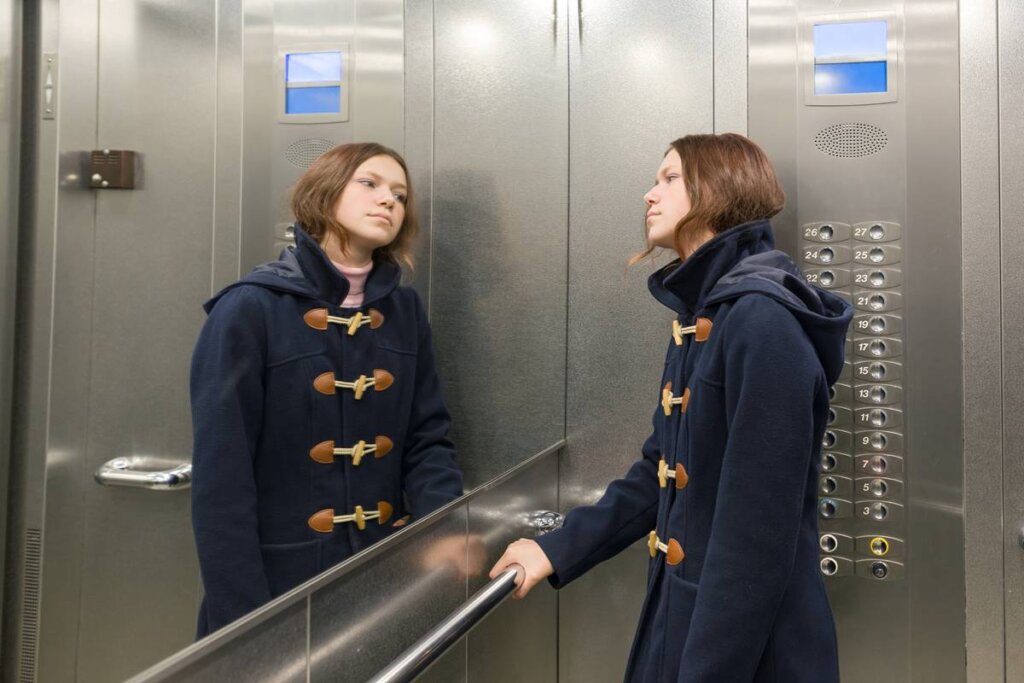Do You Know Why Elevators Have Mirrors?


Written and verified by the psychologist Valeria Sabater
Since time immemorial, mirrors have been a part of our daily lives. In fact, fascinating mirrors made of obsidian from ancient Anatolia (Turkey) dating from 6000 BC have been preserved. The Egyptians also used them in their beauty rituals. On the other hand, in the Middle Ages, their use was restricted.
At certain times and in certain cultures mirrors were thought to bring bad luck. But, today, we no longer know how to live without them. Indeed, we’ve become addicted to reflections of our own images and mirrors have become a part of our daily lives. We find them in bathrooms, bedrooms, wardrobes, dressing rooms, museums, and shopping centers. As a matter of fact, it’s difficult to find a space without them.
The normalization of mirrors in our daily lives is such that we hardly question their presence. So, you may never have even wondered why there are always mirrors in elevators.
Naturally, you use them to make sure that you’ve combed your hair properly every morning when you go to work or to take the classic selfie. But, their use in these spaces also fulfills a clear psychological purpose.
Although riding an elevator is common for most of us, some people are afraid of them which can be extremely distressing for them.

Phobias and why elevators have mirrors
An elevator is like an autonomous vehicle. They allow us to move vertically through our cities. Elevators are an example of modernity. Today, there can be few actions more commonplace than riding in them. But, as routine and comfortable as it may be for most of us, this isn’t the case for everyone.
There’s no specific term for elevator phobia but there’s no doubt that it exists. Moreover, it affects millions of people around the world. The fact that it has no designated term is due to the fact that it can be triggered by one of the following conditions:
- Agoraphobia. The individual has the irrational fear that they may become trapped in a place from which they can’t escape or get help. This can happen both in open and closed spaces.
- Claustrophobia. The individual fears enclosed spaces.
As a rule, those who feel anxious in elevators may also fear getting on planes, entering tunnels, being in enclosed spaces without windows, or being trapped in the middle of a concert surrounded by many people.
Therefore, back in 1850, when Elisha Graves Otis began to mass-produce elevators, a mechanism had to be devised so that people with phobias could use them.
A feeling of space distracts those who fear elevators
If you’ve ever wondered why elevators have mirrors, the answer is simple. They make it easier for those with a phobia of them to conquer their fears. In fact, placing mirrors in these extremely small spaces creates a greater feeling of spaciousness. Consequently, the individual feels that they have more space and their feelings of oppression decrease.
Furthermore, mirrors also act as distractors. Indeed, nothing attracts our attention as much as seeing our reflections. Our brains divert their gazes from fear and irrational thoughts and focus on us. Therefore, we concentrate on our own images and those around us.
A study conducted by the University of Georgia (Greece) claims that the only way to regulate elevator phobia is through exposure therapy. The patient must be gradually exposed to the focus of their fear in order to face and rationalize it. Having the support of a mirror further improves this process of improvement.
The risk of suffering an accident in an elevator is really low. However, the world of cinema has often portrayed terrifying and distressing images of different incidents in these contraptions.

More fascinating reasons
Elevators have contained mirrors for many decades. But, their installation in these reduced spaces isn’t only to help phobia sufferers. In fact, there are some other fascinating reasons:
1. The safety factor
An elevator is a small space often entered by small groups of strangers. Having an almost panoramic view of what’s happening next to us and behind us makes us feel more secure. For example, we know who’s behind us and what they’re doing and we can keep an eye on each other to make sure that no one steals from us. Therefore, elevator mirrors provide safety.
2. Greater mobility for people with special needs
A person in a wheelchair can better guide themselves when entering and exiting an elevator if there are mirrors. They’re able to pay more attention and feel more independent when it comes to moving around as they don’t have to count on the help of others.
3. Mirrors replace piped music
Some people talk about the weather with their neighbors when they ride the elevator. But when we share spaces with complete strangers, we don’t tend to start conversations. After all, we know that we’ll be out in a few minutes and may never see them again. So, it’s not really worth it. Despite this fact, these moments can be rather uncomfortable.
A few decades ago, piped music was used in elevators. Today, we have mirrors. Seeing ourselves reflected in each other distracts us, lightens the mood, and we don’t have to look at the ground. Indeed, there are infinite nuances for us to observe before the doors open.
Although it’s true that an elevator is one of the most popular settings for selfies, the presence of mirrors in them has made life easier for millions of people. They’re there for a specific purpose that we should appreciate. They deactivate our fears by distracting us as well as creating an illusion of amplitude. This is pure magic.
Since time immemorial, mirrors have been a part of our daily lives. In fact, fascinating mirrors made of obsidian from ancient Anatolia (Turkey) dating from 6000 BC have been preserved. The Egyptians also used them in their beauty rituals. On the other hand, in the Middle Ages, their use was restricted.
At certain times and in certain cultures mirrors were thought to bring bad luck. But, today, we no longer know how to live without them. Indeed, we’ve become addicted to reflections of our own images and mirrors have become a part of our daily lives. We find them in bathrooms, bedrooms, wardrobes, dressing rooms, museums, and shopping centers. As a matter of fact, it’s difficult to find a space without them.
The normalization of mirrors in our daily lives is such that we hardly question their presence. So, you may never have even wondered why there are always mirrors in elevators.
Naturally, you use them to make sure that you’ve combed your hair properly every morning when you go to work or to take the classic selfie. But, their use in these spaces also fulfills a clear psychological purpose.
Although riding an elevator is common for most of us, some people are afraid of them which can be extremely distressing for them.

Phobias and why elevators have mirrors
An elevator is like an autonomous vehicle. They allow us to move vertically through our cities. Elevators are an example of modernity. Today, there can be few actions more commonplace than riding in them. But, as routine and comfortable as it may be for most of us, this isn’t the case for everyone.
There’s no specific term for elevator phobia but there’s no doubt that it exists. Moreover, it affects millions of people around the world. The fact that it has no designated term is due to the fact that it can be triggered by one of the following conditions:
- Agoraphobia. The individual has the irrational fear that they may become trapped in a place from which they can’t escape or get help. This can happen both in open and closed spaces.
- Claustrophobia. The individual fears enclosed spaces.
As a rule, those who feel anxious in elevators may also fear getting on planes, entering tunnels, being in enclosed spaces without windows, or being trapped in the middle of a concert surrounded by many people.
Therefore, back in 1850, when Elisha Graves Otis began to mass-produce elevators, a mechanism had to be devised so that people with phobias could use them.
A feeling of space distracts those who fear elevators
If you’ve ever wondered why elevators have mirrors, the answer is simple. They make it easier for those with a phobia of them to conquer their fears. In fact, placing mirrors in these extremely small spaces creates a greater feeling of spaciousness. Consequently, the individual feels that they have more space and their feelings of oppression decrease.
Furthermore, mirrors also act as distractors. Indeed, nothing attracts our attention as much as seeing our reflections. Our brains divert their gazes from fear and irrational thoughts and focus on us. Therefore, we concentrate on our own images and those around us.
A study conducted by the University of Georgia (Greece) claims that the only way to regulate elevator phobia is through exposure therapy. The patient must be gradually exposed to the focus of their fear in order to face and rationalize it. Having the support of a mirror further improves this process of improvement.
The risk of suffering an accident in an elevator is really low. However, the world of cinema has often portrayed terrifying and distressing images of different incidents in these contraptions.

More fascinating reasons
Elevators have contained mirrors for many decades. But, their installation in these reduced spaces isn’t only to help phobia sufferers. In fact, there are some other fascinating reasons:
1. The safety factor
An elevator is a small space often entered by small groups of strangers. Having an almost panoramic view of what’s happening next to us and behind us makes us feel more secure. For example, we know who’s behind us and what they’re doing and we can keep an eye on each other to make sure that no one steals from us. Therefore, elevator mirrors provide safety.
2. Greater mobility for people with special needs
A person in a wheelchair can better guide themselves when entering and exiting an elevator if there are mirrors. They’re able to pay more attention and feel more independent when it comes to moving around as they don’t have to count on the help of others.
3. Mirrors replace piped music
Some people talk about the weather with their neighbors when they ride the elevator. But when we share spaces with complete strangers, we don’t tend to start conversations. After all, we know that we’ll be out in a few minutes and may never see them again. So, it’s not really worth it. Despite this fact, these moments can be rather uncomfortable.
A few decades ago, piped music was used in elevators. Today, we have mirrors. Seeing ourselves reflected in each other distracts us, lightens the mood, and we don’t have to look at the ground. Indeed, there are infinite nuances for us to observe before the doors open.
Although it’s true that an elevator is one of the most popular settings for selfies, the presence of mirrors in them has made life easier for millions of people. They’re there for a specific purpose that we should appreciate. They deactivate our fears by distracting us as well as creating an illusion of amplitude. This is pure magic.
All cited sources were thoroughly reviewed by our team to ensure their quality, reliability, currency, and validity. The bibliography of this article was considered reliable and of academic or scientific accuracy.
- Hodgin KL, Graham DJ. Mirror, Mirror by the Stairs: The Impact of Mirror Exposure on Stair versus Elevator Use in College Students. Front Public Health. 2016 Apr 25;4:80. doi: 10.3389/fpubh.2016.00080. PMID: 27200333; PMCID: PMC4843211.
- Laura L. Myers (1997) Exposure therapy in the brief treatment of an elevator phobia, Scandinavian Journal of Behaviour Therapy, 26:1, 22-26, DOI: 10.1080/16506079708412032
This text is provided for informational purposes only and does not replace consultation with a professional. If in doubt, consult your specialist.







